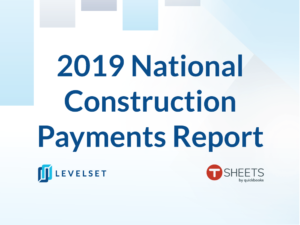
Getting paid in construction is slow, hard, and stressful – that’s the takeaway from a survey of over 500 construction professionals conducted in collaboration between Levelset and Quickbooks Time. The construction industry is plagued by slow payment; a well-documented problem making payment slower in construction than in any other industry (83 days on average!). This impacts everyone on a job from lenders and developers to subcontractors and material suppliers. This National Construction Payments Report summarizes the key findings of a survey of 503 construction professionals across the nation on the state of payments in the construction industry.
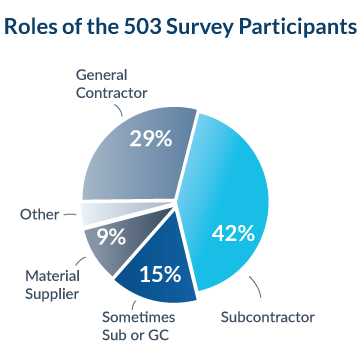
Note: The survey responses include a number of open-ended answers, some of which are included in this report where relevant. This survey was conducted in August 2019. It is the second annual construction payment survey between Quickbooks Time & Levelset.
Read more Construction Payment Reports
- 2021 Construction Cash Flow & Payment Report
- 2020 National Construction Payment Report
- 2018 National Construction Payment Report
Payment Is Stressful & Cash Is Tight For Subcontractors: Key Survey Take-Aways
- About half of US contractors do not get paid on time, causing serious cash flow issues
- Of those reporting payment issues, the majority are subcontractors (67%) and nearly a third are GCs (30%).
- More than half (58%) of respondents have filed a mechanics lien and almost all (98%) have had to threaten to file a lien in the past.
- 42% of contractors say that they pay their subcontractors or suppliers before they get paid by their customers. To help with cash flow, they feel pressure to make financial concessions by providing discounts, flexible payment options, and/or interest-free late payments while dipping into their savings or taking out loans to cover shortages.
- Over half of respondents (57%) reported retainage to be a challenge, with at least 5% of payment being withheld on 46% of projects.
- Most people surveyed (75%) wanted more visibility into how others are paying people and getting paid on their job.
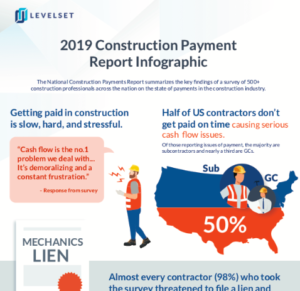
Key Takeaways: Infographic
View, download, or share key takeaways from the 2019 National Construction Payments Report in an easy-to-understand infographic.
Contractors struggle with cash flow
Contractors are frequently forced to chase down paychecks and suffer from cash flow issues (61%). In the survey, contractors report not being paid on time, not being paid in full, and not having anywhere to turn for help when struggling with slow payment.
“Cash flow is the number one problem we deal with,” reported one respondent. “It is demoralizing and a constant frustration.”
Contractors are not paid on time
About half (49%) of construction payments are not made on time as required by the original contract, with subcontractors typically catching the brunt of the delay.
Contractors also report having to chase down their payments. Funds are rarely volunteered after work is complete—it usually takes phone calls, emails, and invoicing a customer to trigger payment, making contractors feel like they have to beg to get paid. Many contractors (39%) say that even after invoices are approved, it still takes 30 days or more to receive payment.
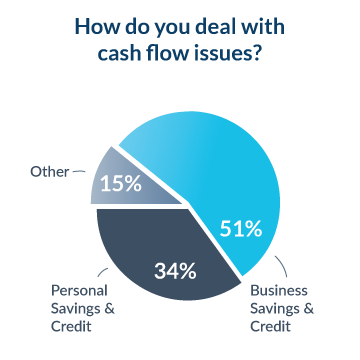
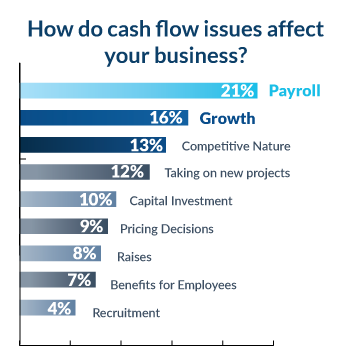
While waiting on payment, contractors struggle to get the cash flow they need. In the survey, companies reported drawing from personal savings (34%) or taking out loans (54%) in order to cover labor and materials while waiting on payment, causing already razor-thin margins to be sliced even thinner.
Contractors are not paid in full
But getting paid late doesn’t always mean getting paid in full. Only three out of every five contractors (61%) are paid in full, on every job—the rest say that back charges, deductions, and other withholdings frequently get tacked on after a project is finished.
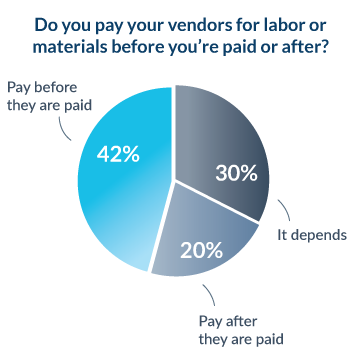
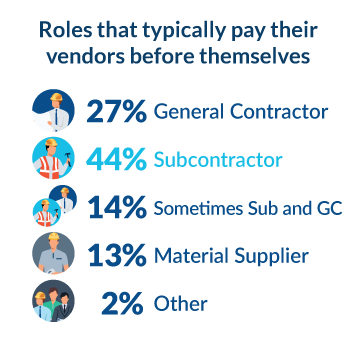
In addition, regardless of how fast they themselves are paid, contractors are still expected to pay their subcontractors on time. In fact, 42% of contractors say that they pay vendors and subcontractors before they pay themselves.
Fighting payment delays with legal action is often not worth a contractor’s time, energy, or funds—so they’ll typically just eat the costs. By floating money on these projects they’re limiting their cash flow which affects their ability to take on new business, pay for tools and materials, and, in some cases, make payroll.
“We don’t have the funding to wait 60-90 days for payments,” said one survey respondent. “Fear of cash flow issues also prevents us from taking on bigger projects, forcing us to spread our resources, time, and energy across multiple, smaller jobs.”
Contractors don’t have much help with cash flow challenges & payment delays
You might expect there to be repercussions for withholding or delaying payments—but you’d be wrong. The majority (78%) of people rarely or never charge interest on late payments. Desperate to get paid at all, over half (55%) of the contractors say they have gone as far as to negotiate payment terms or even provide a discount. About one in ten contractors do this often.
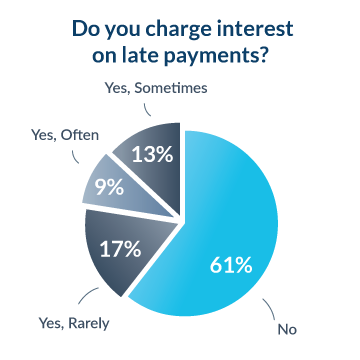
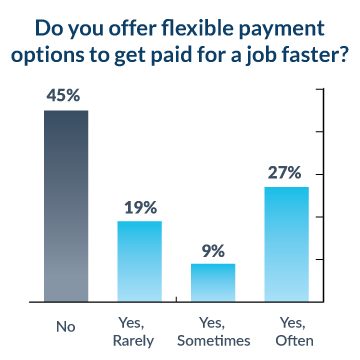
While contractors could turn to file a mechanics lien or escalating their demands, they are scared to do this, with 48% of contractors giving up their lien rights in fear of losing their customers.
Only a tiny percentage of contractors (4%) consistently receive an upfront deposit on their jobs. Half the time (50%), contractors report getting paid in installments, or receiving payment only after the project is completed and the money has managed to trickle down the payment chain.
“I’d rather lose a deal than accept a bad one.”
Survey respondent
Used to an industry of slow payments, contractors might not realize there’s a problem until weeks after they’ve finished the job. After identifying there’s a problem, it typically still takes an additional two weeks or more to get paid. One in four contractors (26%) wait a month or more.
All too frequently, contractors are waiting and, ultimately, fighting for their paychecks weeks or months after performing the work.
“I have started becoming more selective about who I will consider entering into an agreement with,” reported one respondent. “I’d rather lose a deal than accept a bad one.”
Contractors want more transparency
Contractors feel like they are in the dark.
“I would LOVE to have a list of contractors who are slow payers.”
Survey respondent
While laws generally require contractors to send payment to their vendors as soon as they receive payment, it’s very difficult for sub-tier parties on projects to know when payments further up the chain are actually being sent.
As a result, subcontractors and material suppliers are often suspicious that late payments are caused—at least in part—by prime contractors withholding money to help their own cash flow issues.
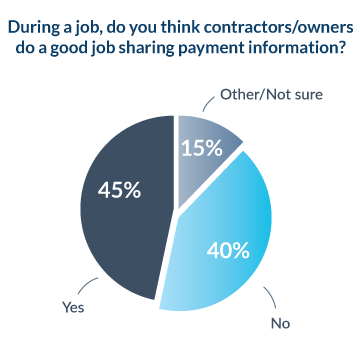
Unsurprisingly, most people in the construction industry (75%) say they want more visibility into how others are paying people on their job, as well as the payment terms and timelines being experienced by others on their jobs.
One respondent said, “I would LOVE to have a list of contractors who are slow payers, or who back charge ridiculous charges.”
Retainage creates cash crunches and disproportionately hurts subcontractors
While you won’t find this practice in any other industry, retainage is a common line item on construction contracts. So frequent, in fact, that the majority (60%) of contractors identify retainage withholding to be an issue.
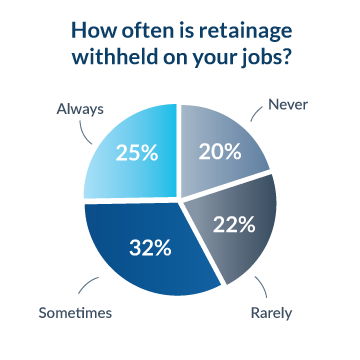
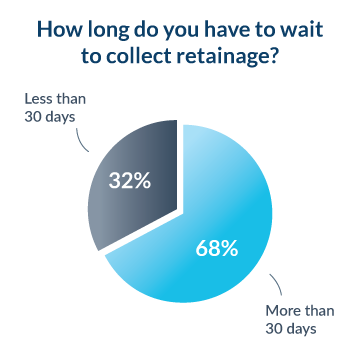
With money being retained on a majority of construction projects in a trillion-dollar industry…that’s a lot of outstanding debt. So where’s the money?
“Retainage is a way for companies to take an extra 10% off the top.”
Survey respondent
Funds are frequently used to cover overhead on other projects (which is illegal) while a majority (66%) of the intended recipients wait a month or more to start collecting.
Collecting on retainage is a major pain point. Contractors say that it can be difficult and time-consuming to track down, which compounds cash flow strains and makes renting equipment and paying suppliers for the job itself extremely difficult.
Many subcontractors find it unnecessarily difficult to collect on retainage and feel, in many cases, forced to file a mechanics lien or bond claim in order to get paid.
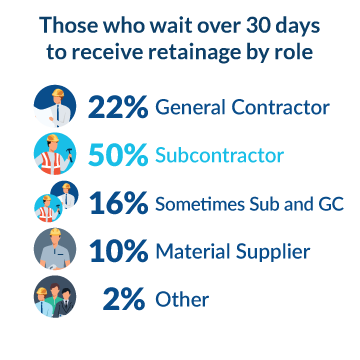
What is retainage? Also called “retention,” this is a practice where the hiring party (e.g. the general contractor) holds back a portion of the payment from the party doing the work (e.g. the subcontractor). The retainage amount is typically 5-10 percent of the contract price and is often withheld from the contractor until the entire project is completed, or “substantially complete.” This means that a cement subcontractor who pours the foundation for a large commercial project may have to wait for months or even years to receive payment. If their profit margin on the project is less than the retainage, they’ll need to make up the gap with personal savings or an interest-bearing loan until they get paid the money retained. (If they get it at all.)
“Retainage in our industry is a way for companies to take an extra 10% off the top,” one survey respondent said. “They will make up reasons not to return it – despite having done the work they requested.”
Subcontractors frequently have a bleak view of retainage, seeing it as a means for the people that hired them to look for excuses to skim money off the top and out of their own pockets. And this makes sense because subcontractors bear the brunt of the retainage burden (see, for example, the American Subcontractors Association (ASA) Study on Retainage in Construction, and our discussion of this report and the impact on subcontractors in The Ultimate Guide to Retainage). The ASA study is in line with the findings of the Levelset & TSheets Construction Payment Report, showing that it’s most often the subcontractors who are waiting on withheld retainage money.
Contractors often rely on mechanics lien filings to get paid
More than half (58%) of the contractors surveyed reported having to file a lien—three-quarters of whom (74%) say they’ve done so in the past year alone.
But this number doesn’t tell the whole story. A large number (41%) of the people surveyed said that fear of damaging relationships has kept them from filing a lien – indicating that the number of liens that could or should have been filed is likely much higher.
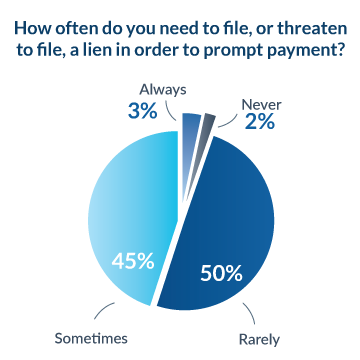
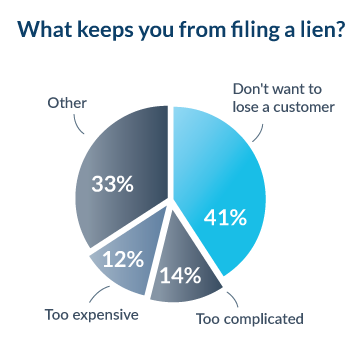
Mechanics liens throw another curveball into construction payments. A mechanics lien is essentially a legal document filed against a property that can protect the filer’s right to get paid. Though often seen as a last resort, a lien is a valuable tool available to contractors and suppliers who have not been paid in full for the work they have completed. It’s the closest thing to a payment guarantee a contractor has because it stops cash flow for everyone on the job and can put an entire project on hold.
Many other documents are exchanged throughout the duration of a project to increase visibility, ensure a smooth-running project, and, hopefully, prevent the need for a lien. But sometimes, even with the use of preventive measures, a mechanics lien is the last tool available to ensure payment. During the month that this survey was conducted, 468 liens were filed by 328 different businesses for a total of $108M in Los Angeles California alone, with individual lien amounts ranging from $500 up to $33 million.
How to make construction payments faster, easier, and more transparent
The construction industry has long been plagued by slow payments that keep getting slower. PWC’s recent cash flow survey showed that contractors wait 83 days on average to get paid — this is 10 days longer than the survey reported last year, and is the longest period of any industry in the world! The Levelset & T-Sheets survey underscores this problem, and shows how this payment status quo is hurting and stressing businesses and business owners.
The fires and friction slowing down payments can be attributed to a few fundamental issues that, fortunately, can be addressed. Construction payment can be improved for all stakeholders with more visibility and communication (and less hide the ball) and by using reasonable and practical payment terms on jobs (and less leverage and bullying).
Parties should play less hide the ball and should encourage multi-tiered communication
Construction jobs are getting more complex with specialties and new players, sometimes crossing state lines—adding to more red tape. While most people have good intentions, issues flare up due to a lack of visibility on a project. Parties up the payment chain might not even be aware that a contractor or a supplier is on a job—much less that their payment is delayed. Parties hired down the payment chain frequently do not have the right information to make themselves visible to the owner and the general contractor.
While visibility documents—like a Preliminary Notice, also called a Notice to Owner or Notice of Furnishing—are often legally required, for decades they’ve been viewed as combative by those up the payment chain who associate them with liens. This discouraged contractors from sending the very documents that can help them increase visibility to speed up payments, and prevent payment problems from happening at all. However, over recent years, there has been a movement to overcome the negative stigma and use visibility documents for better communication and smoother payments.
Parties should avoid bullying and use reasonable payment terms
Many companies in the survey shared that they either require a down payment upfront, request installments throughout the projects, or require the owner to purchase the materials upfront to limit their own liability and help with cash flow. Other contractors have been able to speed up payments and improve cash flow by working only with customers who have a good track record or those with a good referral from someone they trust.
“Chasing down money…is the worst part of my business.”
Survey respondent
The construction industry is built on trust and relationships, but the fear of damaging trust and relationships eventually leads to contractors waiting 83 days on average to get paid. Up and down the chain, people are waiting to get paid, which compounds cash flow issues for everyone. In many cases, the only choice is to wait, offer discounts, or take out loans to cover overhead.
Despite complex practices and processes that limit visibility and slow down payments, there has been little innovation over the years to address these challenges. However, there has been a lot more awareness about the issue than ever before, and there is a willingness to change for a better future. More efforts are being made in the industry to surface data and insights to help construction businesses make better decisions and keep cash flow healthy. Making information accessible for everyone is a powerful way to even the playing field and make payments fair for everyone on the payment chain.
“What I refer to as chasing down money and/or asking for payment is the worst part of my business,” one respondent admitted. “I loathe collecting money, especially when I truly need it.”
About Levelset
Levelset helps contractors and suppliers get payment under control, and sees a world where no one loses a night’s sleep over payment.
Over 500,000 contractors and suppliers connect on Levelset’s cloud-based platform to make payment processes stress-free. Users easily exchange payment documents like lien waivers, pay applications, and preliminary notices, they see a complete picture of who is on their job, and are empowered with the resources and knowledge they need to be confident in payment. The results are faster payments and fewer surprises.
Survey Reference
Levelset and Quickbooks Time welcome the reuse of this data under the terms of the Creative Commons Attribution License 4.0, which permits unrestricted use, distribution, and reproduction in any medium, provided the original source is cited with attribution to “Levelset and Quickbooks Time.”